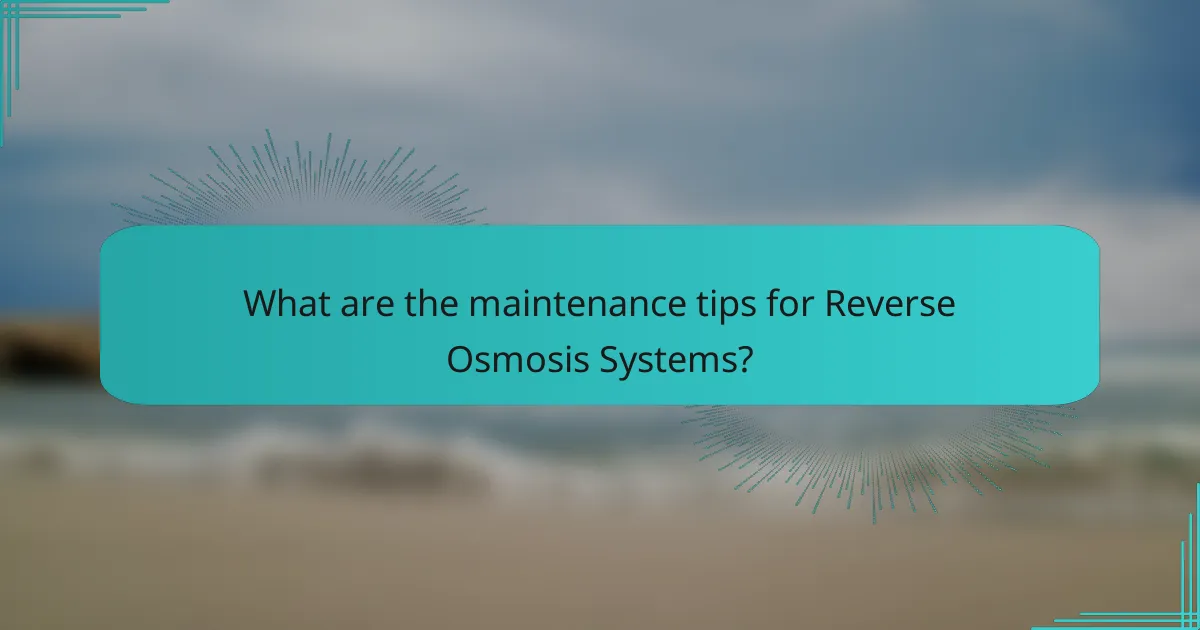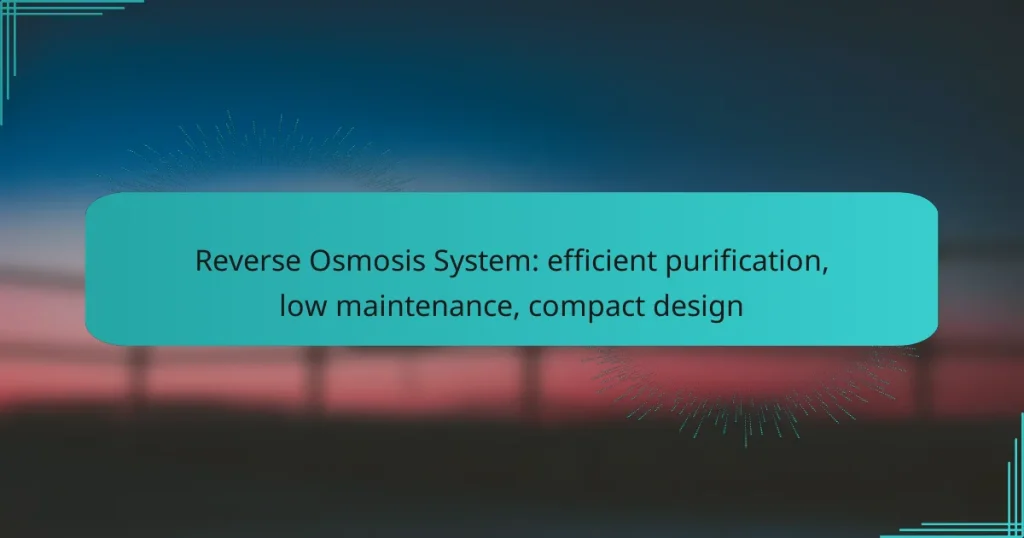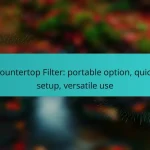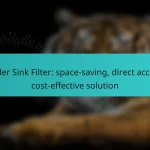A Reverse Osmosis (RO) system is an excellent solution for efficient water purification, effectively removing contaminants to provide clean and safe drinking water. With its low maintenance requirements and compact design, it is ideal for households seeking to enhance their water quality without the burden of extensive upkeep. These systems are easy to install and fit seamlessly into various living spaces, making them a practical choice for any home.

What are the benefits of a Reverse Osmosis System in the UK?
A Reverse Osmosis (RO) system offers several advantages for water purification in the UK, including efficient removal of contaminants, low maintenance needs, and a compact design suitable for various living spaces. These systems are ideal for households looking to improve their drinking water quality without extensive upkeep.
Efficient purification of drinking water
Reverse Osmosis systems effectively filter out impurities from drinking water, including heavy metals, chlorine, and other harmful substances. This purification process typically removes up to 95-99% of total dissolved solids (TDS), ensuring that the water is safe and tastes better.
In the UK, where water quality can vary, an RO system can provide peace of mind by delivering consistently clean water. It’s particularly beneficial for areas with hard water or high levels of contaminants.
Low maintenance requirements
One of the key benefits of Reverse Osmosis systems is their low maintenance needs. Most systems require filter changes every 6-12 months, depending on usage and water quality. Regular maintenance is straightforward and can often be performed by homeowners without professional assistance.
Additionally, many modern RO systems come with indicators that alert users when it’s time to replace filters, making upkeep even easier. This reliability means you can enjoy clean water without frequent, costly service calls.
Compact design for small spaces
Reverse Osmosis systems are designed to fit in tight spaces, making them ideal for kitchens with limited room. Many units can be installed under the sink, freeing up counter space while still providing high-quality water.
With dimensions often comparable to a standard kitchen appliance, these systems can easily integrate into your home without requiring significant modifications. This compact design allows homeowners in urban areas or smaller homes to benefit from advanced water purification technology.

How does a Reverse Osmosis System work?
A reverse osmosis system purifies water by forcing it through a semi-permeable membrane that removes contaminants. This process effectively separates impurities from the water, resulting in clean, safe drinking water.
Multi-stage filtration process
The multi-stage filtration process in a reverse osmosis system typically involves several filters that work sequentially. Initially, a pre-filter removes larger particles like sediment and chlorine, which can damage the membrane. Following this, a carbon filter further reduces chemicals and odors, preparing the water for the final purification stage.
Membrane technology explanation
The core of a reverse osmosis system is its membrane, which is designed to allow only water molecules to pass through while blocking larger molecules and ions. Most membranes are made from thin-film composite materials, which enhance their efficiency and durability.
Membrane technology operates on the principle of pressure; water is pushed through the membrane, creating a flow that separates clean water from contaminants. Regular maintenance, such as replacing the membrane every couple of years, is essential to ensure optimal performance and water quality.

What are the top Reverse Osmosis Systems available in the UK?
The top reverse osmosis systems in the UK focus on efficient purification, low maintenance, and compact design. These systems are designed to remove contaminants from water, ensuring safe drinking water while being easy to install and maintain.
Brita Reverse Osmosis System
The Brita Reverse Osmosis System is known for its user-friendly design and effective filtration capabilities. It typically features a multi-stage filtration process that removes impurities while retaining essential minerals.
Installation is straightforward, making it suitable for various home settings. Regular maintenance involves changing filters every six months, which is manageable for most users.
AquaTru Reverse Osmosis System
AquaTru offers a unique four-stage filtration system that provides thorough purification. This system is compact, making it ideal for kitchens with limited space, and it effectively removes up to 99% of contaminants.
One of its key advantages is the ease of filter replacement, which can be done without tools. Users should consider the initial investment, as it may be higher than some alternatives, but the long-term savings on bottled water can be significant.
iSpring Reverse Osmosis System
The iSpring Reverse Osmosis System is praised for its high water production rate and advanced filtration technology. It typically includes a five-stage filtration process, ensuring comprehensive removal of pollutants.
This system is designed for DIY installation, with clear instructions provided. Maintenance involves changing filters approximately every six to twelve months, depending on water quality, making it a practical choice for many households.

How to choose the right Reverse Osmosis System?
Choosing the right reverse osmosis system involves assessing your specific water needs, including the quality of your water and the contaminants present. It’s essential to evaluate the system’s capacity and size to ensure it fits your household requirements and space constraints.
Consider water quality and contaminants
Start by testing your water to identify the specific contaminants present, such as chlorine, lead, or nitrates. Knowing the water quality helps you select a reverse osmosis system equipped to remove those impurities effectively.
Common contaminants that reverse osmosis systems can address include heavy metals, dissolved solids, and certain microorganisms. Look for systems that meet or exceed local water quality standards, ensuring they are certified for the contaminants you need to remove.
Evaluate system capacity and size
Assess the capacity of the reverse osmosis system to ensure it meets your daily water consumption needs. Most systems range from producing a few gallons per day to over ten gallons, depending on household size and usage.
Additionally, consider the physical size of the system. Compact designs are available that fit under sinks or in small spaces, making them suitable for apartments or homes with limited room. Ensure the system’s dimensions align with your installation area to avoid any space issues.

What is the installation process for a Reverse Osmosis System?
The installation process for a Reverse Osmosis (RO) system typically involves several straightforward steps that ensure efficient purification of water. This process can be completed by a homeowner with basic plumbing skills or by hiring a professional for optimal results.
Step-by-step installation guide
Begin by gathering all necessary tools and components, including the RO unit, water supply adapter, drain saddle, and tubing. Shut off the water supply and prepare the installation site, usually under the kitchen sink.
Next, install the water supply adapter to connect the RO system to your existing water line. Follow this by attaching the drain saddle to the sink’s drain pipe, ensuring it is secure to prevent leaks. Finally, connect the tubing from the RO unit to the water supply and drain, and install the faucet on the sink for dispensing purified water.
Professional installation options
If you prefer to avoid DIY installation, hiring a professional can ensure that your Reverse Osmosis system is set up correctly. Many plumbing services offer installation for RO systems, typically charging a flat fee or hourly rate, which can vary based on location and complexity.
When choosing a professional, look for licensed plumbers with experience in water filtration systems. They can also provide guidance on system maintenance and troubleshooting, ensuring your RO system operates efficiently for years to come.

What are the maintenance tips for Reverse Osmosis Systems?
Maintaining a reverse osmosis system is essential for ensuring its efficiency and longevity. Regular upkeep includes timely filter replacements and proper cleaning procedures to prevent contamination and performance issues.
Regular filter replacement schedule
To keep your reverse osmosis system functioning optimally, adhere to a regular filter replacement schedule. Typically, pre-filters should be replaced every 6 to 12 months, while the RO membrane may last 2 to 3 years depending on water quality and usage.
Check the manufacturer’s guidelines for specific recommendations, as some systems may have unique requirements. Keeping a calendar reminder can help you stay on track with replacements.
System cleaning procedures
Cleaning your reverse osmosis system is crucial for maintaining water quality. Perform a thorough cleaning every 6 months, which includes sanitizing the storage tank and flushing the system with a cleaning solution recommended by the manufacturer.
Ensure to follow the cleaning instructions carefully to avoid damaging components. Regular cleaning helps prevent bacterial growth and keeps the system running efficiently, ensuring you have access to clean water.

What are the costs associated with Reverse Osmosis Systems?
The costs of Reverse Osmosis (RO) systems can vary widely based on factors such as system size, installation, and maintenance. Generally, initial investments can range from a few hundred to several thousand dollars, with ongoing expenses for filters and energy usage.
Initial Purchase Costs
Initial purchase costs for a Reverse Osmosis system typically range from $200 to $2,000, depending on the system’s capacity and features. Smaller, under-sink units are usually less expensive, while larger, whole-house systems can be significantly pricier. It’s essential to consider the long-term benefits of higher-quality systems, which may offer better filtration and durability.
Installation Expenses
Installation expenses can add an additional $100 to $500 to the overall cost, depending on the complexity of the setup and local labor rates. Some systems are designed for DIY installation, which can save money, but professional installation ensures proper setup and adherence to local plumbing codes.
Maintenance and Operating Costs
Maintenance costs for Reverse Osmosis systems primarily involve replacing filters and membranes, which can range from $50 to $300 annually. Regular maintenance is crucial for optimal performance, as neglected systems may lead to reduced efficiency and increased water waste. Additionally, consider the energy costs associated with running the system, which are generally low but can vary based on usage.
Long-Term Value
Investing in a quality Reverse Osmosis system can provide significant long-term value by improving water quality and reducing bottled water expenses. Over time, the savings from decreased bottled water purchases and improved health can offset the initial and ongoing costs. When evaluating options, consider the system’s lifespan and warranty, as these factors can impact overall value.


